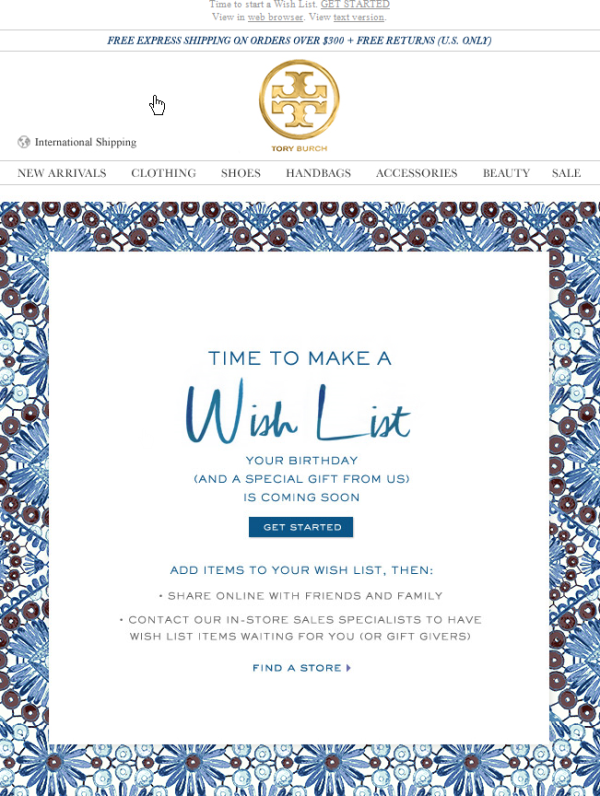How Email Marketers Can Make Birthdays Come More Than Once A Year
- Fahad H

- Mar 12, 2014
- 3 min read
As you evaluate your 2013 email programs and work on your 2014 initiatives, be sure to take a hard look at how much of your revenue from email is attributed to triggered programs, as compared with promotional emails.
From my experience, 20% is a good, general target for the amount of overall revenue that should be attributed to triggered programs.
Triggers are key to a successful email program; they have higher engagement metrics because they are based on user behaviors or data and higher ROI because they have minimal ongoing operational costs.
Triggers With Opportunity
Welcome email(s) will typically have the highest volume and revenue, followed by abandoned shopping cart trigger(s). Moving down the list, there is more variance depending on your business and the kinds of triggers you have implemented.
I recommend performing an analysis of send volume and revenue-per-email (RPE) against all of your triggered campaigns, and then honing in on the triggers that have anomalies.
For instance, a trigger with high volume but low revenue-per-email (RPE) would indicate a need to revisit its timing, creative and the overall click-through experience. A trigger with low volume but high RPE might indicate a need to identify and target a larger audience for a similar send.
A great example of the latter instance is the average birthday email. Who doesn’t love a treat on their birthday? And who doesn’t love to treat themselves for their birthday? It’s because of these behaviors that birthday emails are high performers for RPE. But even with this high performance, so many retailers still have incomplete databases that lack birthdays for most subscribers.
And, it’s no surprise. After all, we know the less information we ask upon sign up, the more likely the subscriber is to opt-in, so marketers made a strategic decision to go after a higher opt-in rate with less information (and who can blame them). But, it’s time to make a change – your revenue depends on it.
Acquisition
Following is a successful case study from Lee (disclosure Lee is a client where I work, DEG) that takes a look at how they increased the number of birthdays on file by 340%.
To begin to gather the non-existent information, Lee sent a responsively-designed email to everyone on file without a birth date with the subject line “Happy Birthday! Or is it?”

The link directed the subscriber to a landing page designed solely to capture the birth date associated with the subscriber.

Upon entering the appropriate information, the subscriber is rewarded with a coupon code and offered a link to start shopping as depicted below:

Results
This email’s open rate was 34% higher than the average open rate for Lee’s promotional emails, and the click-through rate was 142% higher than average. Of the subscribers who clicked through, 81% completed the form. As an added bonus, this campaign also generated revenue, which was not a primary goal. This email has been so successful, it is now sent once a quarter, with variations on creative.
Through campaigns like this, Lee has successfully increased the number of birthdays on file by 340% in less than a year. In turn, the email sent on the subscriber’s actual birthday (see below) deploys to a much larger audience, resulting in increased revenue.

Beyond One Birthday Trigger
After increasing the volume of birthday sends, consider how you could extend the life of this program beyond the one email on the subscriber’s birthday. For example, Lee chose to add a half-birthday celebration into the mix. Increasing the sophistication of triggers involves setting up a series of emails and the birthday campaign is no different!
The half-birthday email is a “surprise and delight” campaign because it is an unexpected trigger for the recipient. The following email was sent with the subject line “A (half) birthday gift for you!”

Next, Lee plans to add a pre-birthday trigger about a month in advance of the date, encouraging the subscriber to create a wish list (which can be shared via email as a hint to friends and family). The Tory Burch company has already implemented a pre-birthday wish list email, as you can see here:

Adding a pre-birthday trigger will complete a three-part triggered birthday campaign for Lee, extending the life of the birthday program with relevant triggered messaging that continues to increase the amount of revenue attributed to triggers.
Trigger Optimization
When evaluating your revenue from triggered email, focus on campaigns with high RPE and low volume. Where appropriate, create campaigns to increase the volume of subscribers to qualify for those triggers.
From there, ask how that triggered program could be more sophisticated beyond its current state. It could be as simple as adding a reminder campaign to subscribers that haven’t converted on the first email, to extend the one-time trigger into a multi-email campaign and further drive revenue from your triggered campaigns.








Comments